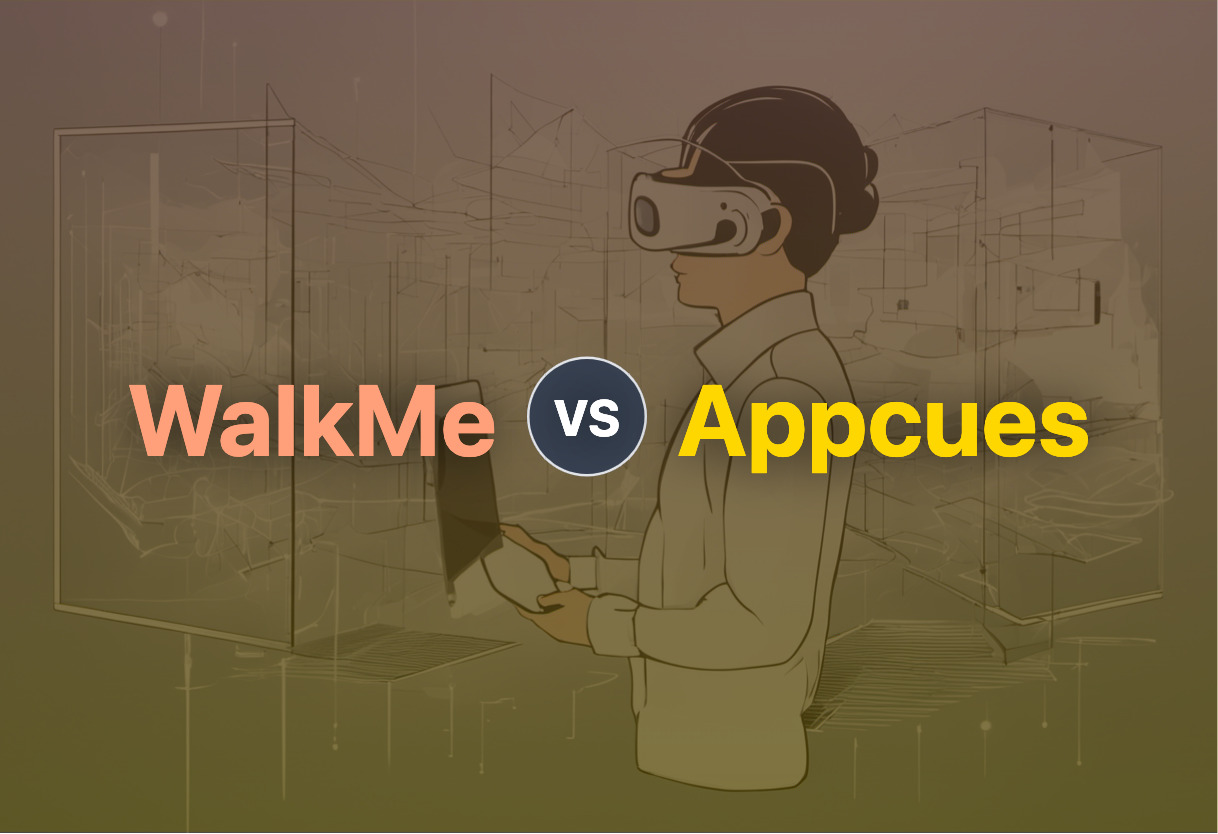For digital adoption, WalkMe reigns, featuring AI-powered guidance and extensive customization. Leveraging its proprietary ‘Smart Walk-Thrus’, it delivers a robust UX experience, essentially for form-based applications. Its learning curve is higher but with excellent customer support. On the other hand, Appcues, a no-code designer of in-app experiences, is a better fit for SaaS products with complex UIs. It offers easy integrations and powerful targeting capabilities, albeit with frequent communication as a requirement.

Key Differences Between WalkMe and Appcues
- WalkMe includes artificial intelligence and machine learning for user guidance, while Appcues is a no-code platform for designing in-app experiences.
- WalkMe caters to organizations for training/onboarding and educational institutions for remote learning, while Appcues focuses more on SaaS products.
- The ‘Smart Walk-Thru’ feature of WalkMe creates interactive user guides, enhancing UX. In contrast, Appcues specializes in stunning, personalized, native-like experiences.
- While WalkMe excels in form-based applications, Appcues is powerful for highly complex UIs in SaaS products.
- WalkMe reportedly reduces B2B support tickets by over 25%, while Appcues nearly eliminates new user support inquiries.
| Comparison | WalkMe | Appcues |
|---|---|---|
| Product Type | Digital Adoption Platform (DAP) | No-code platform for in-app experiences |
| USP | Onboarding, Training, User Interface Optimization | Onboarding, User Engagement and Interaction |
| Main Markets | Organizational training/onboarding and Educational Institutions | Health, Wellness, Fitness industry and Computer software industry |
| User Experience | Intuitive UX, Compatibility with Data and Content | Personalized native-like experiences, Turnkey event visualization |
| Challenges | Complex navigation, Dated UX, High IT demand | Poorly communicated software updates |
| Features | Smart Walk-thrus, In-app Onboarding, Testing and Assessment Tools | No-code Editor, Analytics and Reporting, Feedback surveys |
| Additional Benefits | Reduces B2B support tickets by over 25%, Training time cut by 50% | Nearly eliminates new user support inquiries |
| Price | Expensive, needs upfront investment | Starts at US$249.00/year |
| Integrations | Works best with form-based applications | Available with Google Analytics, Mixpanel, HubSpot |
What Is WalkMe and Who’s It For?
WalkMe is a forefront Digital Adoption Platform (DAP), leveraging the power of artificial intelligence, machine learning, and contextual guidance to optimize user interfaces. It serves as a catalyst for remote learning, training, and onboarding. The digitally bound organizations that rely on structured training and the educational institutions resorting to remote learning form their prime market.
This platform proves essential in attenuating training time and bolstering platform engagement while simultaneously decreasing support demand. Its proprietary ‘Smart Walk-Thrus’ feature enables the creation of interactive user guides, thereby enhancing UX. Though its complexity may form a bit of a challenge, the potential benefits can not be neglected.

Pros of WalkMe
- Significant reduction in training time
- Enhanced platform engagement
- Lowered support demand
- Customized walk-throughs to improve product adoption
Cons of WalkMe
- Complex navigation
- Dated UX
- High IT support demand
- Costly upfront investment needed
What Is Appcues and Who’s It For?
Appcues is a no-code platform delivering in-app experiences that are stunning, personalized, and mirror native experiences. It targets the right user at the unfortunately right time through intuitive event visualizations and performance-tracking dashboards. The platform is mostly used for onboarding, notably reducing new user support inquiries.
Ranging from tracking user interaction to targeting and optimizing user engagement, Appcues excels in customer experience. The software finds its daily and weekly usage in the health, wellness, fitness, and computer software industry, and monthly usage in the information services industry.

Pros of Appcues
- Personalized native-like experiences
- Potent tool for complex UI in SaaS products
- Effective onboarding with minimal user support inquiries
- No-code editor for creating in-app guidance
Cons of Appcues
- Poorly communicated software updates
- Not ideal for streamlined UI or minor communication concerns
WalkMe vs Appcues: Pricing
WalkMe positions itself as a high-value investment needing substantial upfront expenditure, whereas Appcues offers a tangible, flat yearly pricing structure starting at $249.00.
WalkMe
WalkMe, while acknowledged for its superior features, demands significant initial financial commitment. The exact pricing scheme isn’t disclosed but it is emphasized that the return on investment can be substantial, reducing B2B support tickets by over 25%, and slashing in-person training requirements and training time by half.
Appcues
Appcues, in stark contrast, provides a clear pricing model for its no-code platform, which commences at $249.00 per year. No free version is offered. The cost-effectiveness combined with robust features like turnkey event visualizations and dashboards for performance tracking bolster its value for money proposition.
WalkMe or Appcues: The Verdict
In the battle of tech titans WalkMe and Appcues, choice depends on experience and needs. Let’s dissect this based on different audience segments.
For Organizational Training and Onboarding
If your realm is organizational training or onboarding, WalkMe tower over Appcues. Its machine learning-fueled DAP, combined with features like Smart Walk-Thrus and comprehensive testing tools, seamlessly blends into your LMS. However, a considerable learning curve and initial investment can’t be sidelined.

For Non-Linear, Complex Applications
For managing non-linear, complex applications, stick to Appcues. Appcues personifies simplicity and elegance. Its no-code platform with stunning in-app experiences are your allies in user engagement. But, it may show signs of weakness in streamlined UIs and software update communication.

For Self-Training and User Engagement
Craving for self-training and power of user engagement? Then WalkMe is your call. Customized walk-throughs geared towards user self-training vastly improve product adoption and user satisfaction, although efforts needed for platform mastering must be considered.

For User Onboarding and Experience
If you’re all about a smooth user onboarding and experience, you might find Appcues irresistible. Its personalization features, paired with a no-code platform, have a solid reputation in eliminating new user support inquiries, albeit poorly communicated software updates might surface occasionally.

For robust organizational training, WalkMe steals the show; for complex applications, opt for Appcues. The former excels at self-training and user engagement, while the latter perfects user onboarding and experience management.
Tiffany Brise
Content writer @ Aircada, patiently awaiting a consumer AR headset that doesn’t suck.





